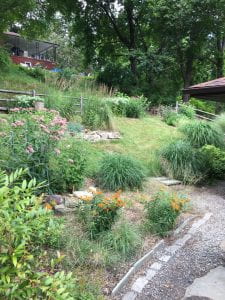By Mary Carol Presutti, New Windsor Master Gardener Volunteer
This article appeared in the May 2021 Issue of Gardening in Orange County.
 The front of my property is flat and user-friendly, but my backyard is another story. A few feet beyond my backdoor is a landscaping challenge that could have impacted the way I garden. Instead, I have learned to live with and embrace a slope that starts at 30 degrees and culminates in an impressive 45-degree angle.
The front of my property is flat and user-friendly, but my backyard is another story. A few feet beyond my backdoor is a landscaping challenge that could have impacted the way I garden. Instead, I have learned to live with and embrace a slope that starts at 30 degrees and culminates in an impressive 45-degree angle.
Initially, I saw my backyard as a challenge that had to be conquered and tamed. I was mesmerized by gardening magazine articles with beautiful photographs of elaborate stone, terraced gardens and the intricate stairs that led to them.
It seems the original owner of the house next door read the same magazines and had flattened a good part of the yard, changed the angle of the hill and added retaining walls at the top. She planted shrubs, as well as annuals, bulbs and perennials with a lot of mulch to keep weeds down.
Over the years, shrub roots and water have pushed the retaining wall and bowed it. New neighbors who purchased the property two years before we moved in found the mass of plantings too labor intensive. Consequently, staghorn sumac (Rhus typhina) and poison ivy (Toxicodendron radicans) have completely overrun the hillside.
I delved into my own hillside project with an eye to next door. Working with what is already there, I have created a series of small gardens slowly working my way up the hill. There is no formal plan to speak of. No large terracing or stairs. Despite the challenges, I don’t feel like I have given up usable planting space in my backyard.
If I wish to level an area, I build a two- or three-course stone raised bed. Just enough to give me a little less angle. I also put in small steps and hardscapes to keep a toehold in steeper areas. The farther up it goes, the more natural things get. Last year I finally started sowing native grass and perennial seeds at the top of the property. There are a few non-native plants like Periwinkle (Vinca minor) left over from the previous owner that have kept the Japanese stiltgrass (Microstegium vimineum) and Poison ivy manageable, so I will leave them for the time being.
To learn more about hillside gardening:
Gardening on Steep Slopes – Mississippi State University Extension
Native Plants for Sunny Slopes – University of Maryland Extension
